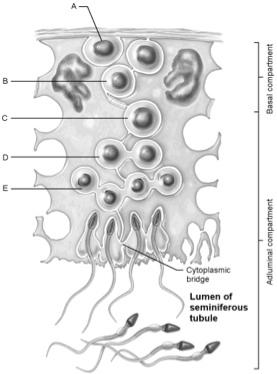
Stem cell.
A
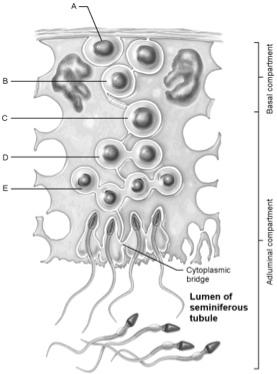
First cells with n number of chromosomes
D
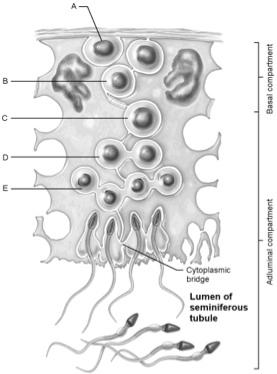
Type B spermatogonia
B
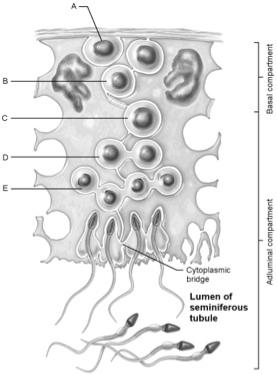
Early spermatids
E
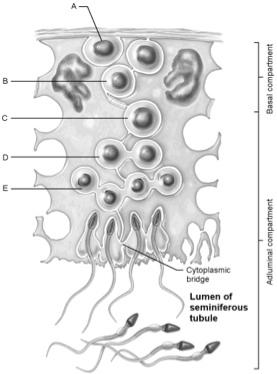
Primary spermatocyte
C
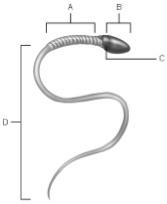
Acrosome
B
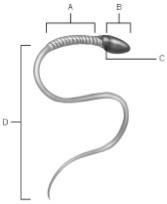
Location of mitochondria
A
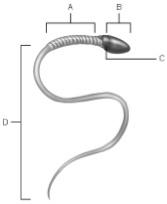
Midpiece
A
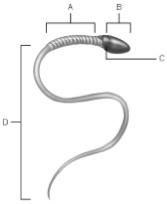
Location of nucleus
C
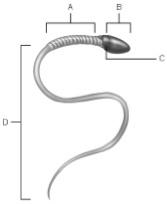
Area of compacted DNA.
C
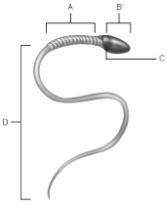
Flagellum.
D
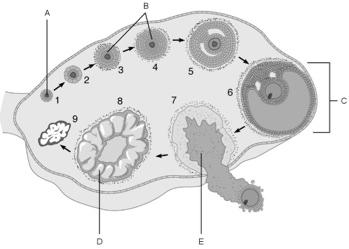
The stage called ovulation.
E
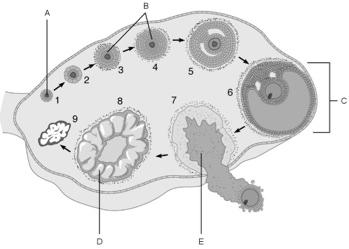
Vesicular (Graafian) follicle
C
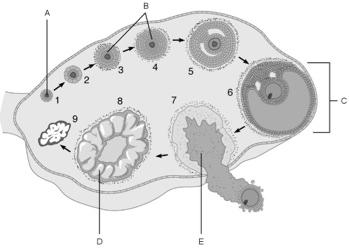
Primary follicles
B
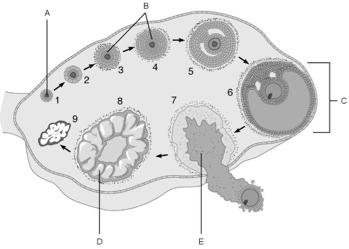
Primordial follicle.
A
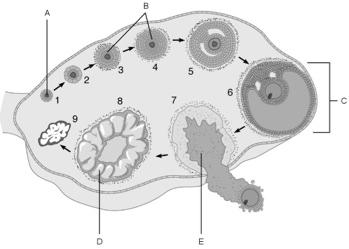
Corpus luteum
D
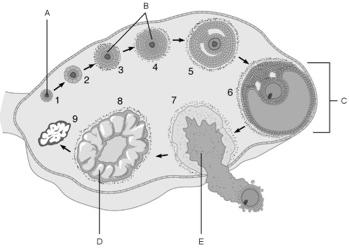
Mature follicle.
C
Where the fetus develops and grows
A) Uterus
B) Scrotum
C) Corpora cavernosa
D) Ovulation
E) Labia majora
A) Uterus
The release of oocyte from ovary
A) Uterus
B) Scrotum
C) Corpora cavernosa
D) Ovulation
E) Labia majora
D) Ovulation
External sac enclosing the testes
A) Uterus
B) Scrotum
C) Corpora cavernosa
D) Ovulation
E) Labia majora
B) Scrotum
Erectile tissue in the male.
A) Uterus
B) Scrotum
C) Corpora cavernosa
D) Ovulation
E) Labia majora
C) Corpora cavernosa
Female homologue of the scrotum.
A) Uterus
B) Scrotum
C) Corpora cavernosa
D) Ovulation
E) Labia majora
E) Labia majora
Human papillomavirus
A) Chlamydia
B) Genital warts
C) Syphilis
D) Genital herpes
E) Gonorrhea
B) Genital warts
Treponema pallidum
A) Chlamydia
B) Genital warts
C) Syphilis
D) Genital herpes
E) Gonorrhea
C) Syphilis
Urethritis in males
A) Chlamydia
B) Genital warts
C) Syphilis
D) Genital herpes
E) Gonorrhea
E) Gonorrhea
Human herpes virus type 2
A) Chlamydia
B) Genital warts
C) Syphilis
D) Genital herpes
E) Gonorrhea
D) Genital herpes
Organism responsible for up to half of the diagnosed cases of pelvic inflammatory disease
A) Chlamydia
B) Genital warts
C) Syphilis
D) Genital herpes
E) Gonorrhea
A) Chlamydia
True/False Questions
It is necessary for the testes to be kept below body temperature.
True
True/False Questions
The prostate atrophies as a man ages, and it usually causes no health problems.
False
True/False Questions
The hormone oxytocin combines with enzymes in semen to enhance sperm motility
False
True/False Questions
When a couple is having difficulty conceiving a child, it is necessary to investigate the sperm of the male
True
True/False Questions
The amount of testosterone and sperm produced by the testes is dependent on the influence of FSH alone.
False
True/False Questions
Ovarian follicles contain mature eggs
False
True/False Questions
Sexually transmitted infections are the most important cause of reproductive disorders.
True
True/False Questions
Reproduction is not possible in males or females until one year after puberty has begun.
False
True/False Questions
The smaller cell produced by oogenesis meiosis I, called the first polar body, is essentially a packet of discarded nuclear material.
True
True/False Questions
Pain during ovulation is called dysmenorrhea
False
True/False Questions
A human egg or sperm contains 23 pairs of chromosomes.
True
True/False Questions
The Pap smear is a test to detect cancerous changes in cells of the cervix
True
True/False Questions
The adenohypophyseal hormone that triggers ovulation is estrogen.
False
True/False Questions
The male urethra serves the urinary system only.
False
True/False Questions
Both tetrads and crossovers are seen during meiosis.
True
True/False Questions
Failure to attain erection is called impotence
True
True/False Questions
Ovulation occurs near the end of the ovarian cycle.
False
True/False Questions
The corpus luteum secretes progesterone only.
False
True/False Questions
Female orgasm is required for conception
False
True/False Questions
The first sign of puberty in females is budding breasts
True
True/False Questions
The primary function of the testes is to produce testosterone.
False
True/False Questions
The stage in meiosis where chromosomal exchange takes place is telophase
False
True/False Questions
The diamond-shaped area between the coccyx, pubic arch, and ischial tuberosities in the female is the vulva.
False
True/False Questions
The soft mucosal lining of the uterus is the endometrium
True
True/False Questions
A scrotal muscle that contracts in response to cold environmental temperature is the cremaster
True
True/False Questions
The secretions of the bulbourethral glands neutralize traces of acidic urine in the urethra and serve as a lubricant during sexual intercourse.
True
True/False Questions
The zona pellucida is formed as the follicle becomes a secondary follicle
True
True/False Questions
The molecule that enhances the ability of testosterone to promote spermatogenesis is inhibin
False
The dartos and cremaster muscles are important to the integrity of the male reproductive system. Which of the following is true about the role they play?
A) They contract to push sperm along the ductus deferens.
B) They regulate the temperature of the testes.
C) They are responsible for penile erection.
D) They contract to allow ejaculation.
B) They regulate the temperature of the testes.
The ability of sperm cells to move along the ductus deferens is due to ________.
A) gravity
B) peristaltic contractions
C) enzymatic activity
D) hormonal action
B) peristaltic contractions
The ability of a male to ejaculate is due to the action of ________.
A) parasympathetic nerves
B) the dartos muscle
C) luteinizing hormone
D) the bulbospongiosus muscles
D) the bulbospongiosus muscles
The most important risk for testicular cancer in young males is ________.
A) smoking
B) a diet high in fat
C) nondescent of the testes
D) sexually transmitted infections
C) nondescent of the testes
5) Which of the following glands are responsible for 60% of the synthesis of semen?
A) the seminal vesicles
B) the bulbourethral glands
C) the prostate
D) the pituitary
A) the seminal vesicles
Which of the following hormones controls the release of anterior pituitary gonadotropins?
A) LH
B) FSH
C) GnRH
D) testosterone
C) GnRH
Development of male reproductive structures depends on which of the following events?
A) that the female hormones are suppressed during pregnancy
B) the suppression of inhibin
C) secretion of male hormones prenatally and lasting into the first few months after birth
D) that human gonadotropin be synthesized in the first week of the pregnancy
C) secretion of male hormones prenatally and lasting into the first few months after birth
The primary function of the uterus is to ________.
A) protect the ovaries
B) synthesize female hormones
C) regulate the ovarian and menstrual cycles
D) receive, retain, and nourish a fertilized ovum
D) receive, retain, and nourish a fertilized ovum
Why is the blood-testis barrier important?
A) because spermatozoa and developing cells produce surface antigens that are recognized as foreign by the immune system
B) because some blood contents are toxic to the spermatozoa
C) because immature sperm cells lose their motility when they encounter any blood component
D) Actually, the blood-testis barrier has no function.
A) because spermatozoa and developing cells produce surface antigens that are recognized as foreign by the immune system
The structures that receive the ovulated oocyte, providing a site for fertilization, are called the ________.
A) Graafian follicles
B) fallopian tubes
C) infundibula
D) fimbriae
B) fallopian tubes
If gametes were diploid like somatic cells, how many chromosomes would the zygote contain?
A) twice the diploid number, and with every succeeding generation, the chromosome number would continue to double and normal development could not occur
B) triple the diploid number, and with every succeeding generation, the chromosome number would continue to triple and normal development would not occur
C) half the diploid number with no change in development
D) There is no relationship between gametes and somatic cells.
A) twice the diploid number, and with every succeeding generation, the chromosome number would continue to double and normal development could not occur
Human egg and sperm are similar in that ________.
A) about the same number of each is produced per month
B) they have the same degree of motility
C) they have the same number of chromosomes
D) they are about the same size
C) they have the same number of chromosomes
The constancy of the chromosome number from one cell generation to the next is maintained through ________.
A) mitosis
B) meiosis
C) cytokinesis
D) DNA synthesis
B) meiosis
Fertilization generally occurs in the ________.
A) ovary
B) uterus
C) vagina
D) fallopian tubes
D) fallopian tubes
Spermiogenesis involves the ________.
A) formation of four haploid cells from a spermatogonium
B) movement of sperm in the female genital tract
C) formation of a functional sperm by the stripping away of superfluous cytoplasm
D) sequence of events in the rete testis
C) formation of a functional sperm by the stripping away of superfluous cytoplasm
All of the following can be considered male secondary sex characteristics except the ________.
A) development of body hair
B) lowering of the voice
C) development of testes as opposed to ovaries
D) increasing mass of the skeleton
C) development of testes as opposed to ovaries
In humans, separation of the cells at the two-cell state following fertilization may lead to the production of twins, which in this case would be ________.
A) dizygotic
B) identical
C) fraternal
D) of different sexes
B) identical
Characteristics of the mature sperm include the ________.
A) presence of two X chromosomes in approximately half the sperm
B) presence of Y chromosomes in approximately half the sperm
C) absence of an acrosome
D) absence of coiled mitochondria
B) presence of Y chromosomes in approximately half the sperm
How do the testes respond to exposure to excessive body warmth?
A) They move close to the pelvic cavity.
B) They move away from the pelvic cavity.
C) Excessive warmth has no effect on the testicles because of their location in the scrotum.
D) Excessive warmth is actually beneficial in that it speeds up the maturation of sperm
B) They move away from the pelvic cavity.
Effects of estrogen include ________.
A) increased oiliness of the skin
B) deepening of the voice
C) growth of the breasts at puberty
D) growth of the larynx
C) growth of the breasts at puberty
Secretion of progesterone stimulates ________.
A) contraction of uterine muscles
B) preparation of the mammary glands for lactation
C) secretory activity of the uterine myometrium
D) development of the female secondary sex characteristics
B) preparation of the mammary glands for lactation
Which of the following statements about sperm is not true?
A) They contain very little cytoplasm or stored nutrients.
B) They are sluggish in an alkaline environment.
C) The acrosome is produced by the Golgi apparatus and contains hydrolytic enzymes.
D) The sperm midpiece consists of mitochondria spiraled tightly around the contractile filaments of the tail.
D) The sperm midpiece consists of mitochondria spiraled tightly around the contractile filaments of the tail.
The cells that produce testosterone in the testis are called ________.
A) spermatocytes
B) spermatogonia
C) sustentacular cells
D) interstitial cells
D
The testicular cells that construct the blood-testis barrier are the ________.
A) spermatocytes
B) spermatogonia
C) sustentacular cells
D) interstitial cells
C) sustentacular cells
Which of the following occurs as a result of undescended testes?
A) Male sex hormones will not be circulated in the body.
B) Sperm will have no means of exit from the body.
C) Inadequate or nonviable sperm will be produced.
D) Inadequate blood supply will retard the development of the testes.
C) Inadequate or nonviable sperm will be produced.
Erection of the penis results from ________.
A) a sympathetic reflex
B) parasympathetic activation of the bulbourethral glands
C) dilation of the veins in the penis
D) a parasympathetic reflex
D) a parasympathetic reflex
Which is not a part of the proliferative phase of the female menstrual cycle?
A) late in this phase, cervical mucus becomes thin and crystalline
B) vesicular follicle growth
C) corpus luteum
D) development of endometrial cells
C) corpus luteum
Which of the choices below is not a function of the vagina?
A) serves as a passageway for the primary oocyte
B) serves as a passageway for menstrual flow
C) is the birth canal
D) receives semen from the penis during sexual intercourse
A) serves as a passageway for the primary oocyte
Select the correct statement about male sexual response.
A) Sympathetic impulses are responsible for causing penile arteriolar dilation, resulting in erection.
B) Erection is the result of vascular spaces in the erectile tissues filling with blood.
C) Expansion of the penile tissues results in dilation of the venous outflow.
D) Ejaculation is the result of parasympathetic stimulation.
B) Erection is the result of vascular spaces in the erectile tissues filling with blood.
Which of the choices below is not a function of testosterone?
A) stimulates the male pattern of development
B) contributes to male sexual behavior and spermatogenesis
C) stimulates protein synthesis
D) stimulates mammary gland development
D) stimulates mammary gland development
Which male hormone inhibits the secretion of FSH?
A) ACTH
B) inhibin
C) ICSH
D) testosterone
B) inhibin
During the secretory phase of the menstrual cycle ________.
A) LH reaches its highest levels
B) progesterone levels are at their highest
C) estrogen reaches its highest levels
D) the Graafian follicle forms
B) progesterone levels are at their highest
Select the correct statement about the uterine cycle.
A) The menstrual phase of the cycle is from day 1 to day 8.
B) During the secretory phase, estrogen levels are at their highest.
C) During the proliferative phase, levels of progesterone rise as the follicle begins to produce more hormone.
D) If fertilization occurs, the corpus luteum is maintained by a hormone secreted by the developing embryo.
D) If fertilization occurs, the corpus luteum is maintained by a hormone secreted by the developing embryo.
Which of the choices below is not a part of the brain-testicular axis?
A) hypothalamus
B) anterior pituitary gland
C) thalamus
D) testes
D) testes
Which of the following statements is true concerning the mammary glands of both males and females?
A) Both sexes are equally prone to breast cancer.
B) All lumps identified in breast tissue are malignant.
C) The only time hormones target breast tissue is during pregnancy and lactation.
D) The mammary glands are modified sweat glands that are actually part of the integumentary system.
D) The mammary glands are modified sweat glands that are actually part of the integumentary system.
Normally menstruation occurs when ________.
A) blood levels of FSH fall off
B) blood levels of estrogen and progesterone decrease
C) blood levels of estrogen and progesterone increase
D) the corpus luteum secretes estrogen
B) blood levels of estrogen and progesterone decrease
The basic difference between spermatogenesis and oogenesis is that ________.
A) during spermatogenesis two more polar bodies are produced
B) the mature ovum is n, while the sperm is 2n
C) in oogenesis, one mature ovum is produced, and in spermatogenesis four mature sperm are produced from the parent cell
D) spermatogenesis involves mitosis and meiosis, but oogenesis involves meiosis only
C) in oogenesis, one mature ovum is produced, and in spermatogenesis four mature sperm are produced from the parent cell
Occasionally three polar bodies are found clinging to the mature ovum. One came from an unequal division of the ovum, but from where did the other two arise?
A) There were originally four polar bodies and one disappeared.
B) One is an undeveloped primary oocyte that failed to mature.
C) The first polar body has also divided to produce two polar bodies.
D) What you really see are two polar bodies and the sperm that will fertilize the egg.
C) The first polar body has also divided to produce two polar bodies.
Which of the following will occur after ovulation?
A) The corpus luteum secretes estrogen only.
B) The endometrium enters its secretory phase.
C) The secretion of anterior pituitary gonadotropins is enhanced.
D) The corpus luteum prepares to become a corpus albicans
B) The endometrium enters its secretory phase.
Why doesn’t semen enter the urinary bladder during ejaculation?
A) There is no common duct between the reproductive system and the urinary system.
B) There is no urge to urinate during sexual intercourse because of the suppression of LH by testosterone buildup in the blood.
C) The smooth muscle sphincter at the base of the urinary bladder closes.
D) Ejaculation is a parasympathetic reflex resulting in no response by urinary contraction muscles.
C) The smooth muscle sphincter at the base of the urinary bladder closes.
Spermatogenesis ________.
A) is the process of releasing mature sperm cells into the lumen of the seminiferous tubule
B) involves a kind of cell division limited to the gametes
C) results in the formation of diploid cells
D) uses mitosis to produce gamete cells
B) involves a kind of cell division limited to the gametes
Which hormone is absolutely necessary for ovulation to occur?
A) LH
B) FSH
C) progesterone
D) estrogen
A) LH
The brain-testicular axis ________.
A) is the tight relationship between the cortex and the control of testicular function
B) involves FSH and LH release
C) involves posterior pituitary release of regulating hormones
D) involves a positive feedback loop control of spermatogenesis
B) involves FSH and LH release
Select the correct statement about testosterone control.
A) GnRH from the hypothalamus causes FSH and LH release from the anterior pituitary.
B) FSH stimulates testicular production of testosterone.
C) Inhibin and testosterone exert positive feedback on the hypothalamus and pituitary.
D) The pineal gland is believed to be the gland that exerts the most influence in testosterone control.
A) GnRH from the hypothalamus causes FSH and LH release from the anterior pituitary.
Which of the following is a correct statement about uterine tubes?
A) The ampulla is the narrow constricted region.
B) The infundibulum is the funnel-shaped region near the ovary.
C) The isthmus is the normal site of fertilization.
D) The mesometrium supports the uterine tubes along their entire length.
B) The infundibulum is the funnel-shaped region near the ovary.
Select the correct statement about the hormonal events of the ovarian cycle.
A) Rising levels of estrogen start follicle development.
B) High estrogen levels result in a surge of LH release.
C) The follicle begins to secrete progesterone in response to estrogen stimulation.
D) The LH surge stimulates further development of the secondary oocyte.
B) High estrogen levels result in a surge of LH release.
Which of these statements about sexually transmitted infections is false?
A) Chlamydia is caused by bacteria that can often be asymptomatic or bring on a wide variety of symptoms.
B) Gonorrhea is caused by a bacterium that can bring on painful discharges in males.
C) Syphilis is caused by a virus that may lead to death if untreated.
D) Genital herpes is caused by a virus that may cause intermittent lesions.
C) Syphilis is caused by a virus that may lead to death if untreated.
Which of the following statements about spermatogenesis is not true?
A) The spermatogonium forms the primary spermatocyte.
B) The primary spermatocyte forms two secondary spermatocytes.
C) The secondary spermatocytes each form two spermatids.
D) Each spermatid forms two sperm.
D) Each spermatid forms two sperm
A boy who has not passed through puberty sustains an injury to his anterior pituitary such that FSH is no longer released, but LH is normal. After he grows to maturity, one would expect that he would ________.
A) be sterile
B) not develop secondary sex characteristics
C) be impotent (unable to have an erection)
D) have impaired function of interstitial cells
A) be sterile
Which of the following statements about the female reproductive process is not true?
A) Fertilization usually occurs in the fallopian tube.
B) Ovulation usually occurs 14 days after the beginning of menses.
C) Rebuilding the endometrium is under the control of prolactin.
D) The monthly discharge of the uterus (menses) is initiated by the decrease in secretion of female hormones.
C) Rebuilding the endometrium is under the control of prolactin.
A low secretion of luteinizing hormone (LH) in the normal male adult would cause ________.
A) decreased testosterone secretion
B) excessive beard growth
C) increased spermatogenesis
D) shrinkage of the anterior pituitary gland
A) decreased testosterone secretion
All of the following statements referring to the uterine cycle are true except ________.
A) FSH and LH directly promote development of the uterine endometrium
B) estrogen is secreted by the developing follicle in the follicular phase of the cycle
C) the corpus luteum is formed from the ruptured follicle after ovulation
D) a decrease in the levels of ovarian hormones signals menstruation
A) FSH and LH directly promote development of the uterine endometrium
Which of the following phases or processes in the monthly reproductive cycle of the female occur simultaneously?
A) maximal LH secretion and menstruation
B) maximal steroid secretion by the corpus luteum and menstruation
C) early follicular development and the secretory phase in the uterus
D) regression of the corpus luteum and a decrease in ovarian progesterone secretion
D) regression of the corpus luteum and a decrease in ovarian progesterone secretion
The duct system of the male reproductive system includes the ________.
A) epididymis
B) urethra
C) ductus deferens
D) corpus spongiosum
D) corpus spongiosum
An ovulating oocyte is actually activated by hormones about ________ days before ovulation.
A) 14
B) 28
C) 85
D) 110
D) 110
Prostate cancer is _______.
A) the number-one cause of death in men
B) sometimes a slow-growing cancer that may never represent a threat to the patient
C) most common in Asians
D) often the result of a distortion of the urethra
B) sometimes a slow-growing cancer that may never represent a threat to the patient
The ________ plexus of testicular veins assists in cooling the testis.
Pampiniform
Surgical cutting of the ductus deferens as a form of birth control is called a(n) ________.
Vasectomy
The erectile tissue around the urethra is the corpus ________.
Spongiosum
The midpiece of the sperm tail contains mostly ________.
Mitochondria
The ________ cells of the testis nourish the newly formed sperm cells.
Sustentacular
The suspensory ligament and mesovarium are part of the ________ ligament.
Broad
A follicle with only a small antrum in it would be classified as a(n) ________ follicle.
Secondary
The small opening of the uterus that sperm would first enter is called the ________.
External os
The portion of the uterine endometrium that is not sloughed off every month is called the ________.
Stratum Basalis
________ is caused by Treponema pallidum
Syphilis